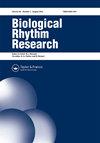光污染:人造光对人体健康影响的系统综述
IF 0.9
4区 生物学
Q3 BIOLOGY
引用次数: 2
摘要
摘要随着工业和经济的发展,人类暴露在人造光下的次数也在增加。因此,目的是分析光污染对人类健康影响的科学证据,重点是人类的主要病理学和污染光的类型。根据PRISMA指南进行了系统综述,在PubMed/Medline、Scielo和Web of Science上搜索原创文章,使用描述符(光[标题])和(健康),以及关键词“光污染”和“(夜间光)和(卫生)”。结果表明,人体暴露是通过电子设备的光和夜间的人造光(环境光和外部光)发生的。大多数描述的人类改变是睡眠障碍、昼夜节律、褪黑激素和皮质醇的改变。此外,还描述了情绪变化和抑郁、精子发生、眼部结构、体温调节和其他心血管疾病的变化。所描述的途径是:i)褪黑激素水平和昼夜节律的变化,ii)直接刺激神经节细胞中对光敏感的光感受器,iii)氧化应激的激活,以及iv)通过激活应激基因改变特定代谢产物。得出的结论是,暴露在人造光下的次数增加主要会引发睡眠和情绪障碍,电子设备和人造夜晚的光线是污染的主要来源。本文章由计算机程序翻译,如有差异,请以英文原文为准。
LIGHT POLLUTION: a systematic review about the impacts of artificial light on human health
ABSTRACT As industry and economy progress, human exposure to artificial light increases. Thus, the aim was to analyze the scientific evidence about the light pollution effect on human health, focusing on the main human pathologies and the types of polluting lights. A systematic review was carried out following the PRISMA guidelines, searching for original articles in the PubMed/Medline, Scielo and Web of Science, using the descriptors (light[title]) AND (health), and the key words “light pollution” and “(light at night) AND (health)”. The result shows that human exposure occurs through lights from electronic devices and artificial (ambient, and external) light at night. Human alterations most described were sleep disturbances, circadian rhythm, melatonin, and cortisol alterations. In addition, were described mood alterations and depression, alterations in spermatogenesis, ocular structures, thermoregulation, and other cardiovascular diseases. The pathways described were: i) changes in melatonin levels, and circadian rhythm, ii) directly stimulation of photoreceptors sensitive to light in ganglion cells, iii) activation of oxidative stress, and iv) alteration in specific metabolites by activating stress genes. It is concluded that the increase in exposure to artificial light triggers mainly sleep and mood disorders, with light from electronic devices and artificial night the mains source of pollution.
求助全文
通过发布文献求助,成功后即可免费获取论文全文。
去求助
来源期刊

Biological Rhythm Research
生物-生理学
CiteScore
3.00
自引率
9.10%
发文量
34
审稿时长
6-12 weeks
期刊介绍:
The principal aim of Biological Rhythm Research is to cover any aspect of research into the broad topic of biological rhythms. The area covered can range from studies at the genetic or molecular level to those of behavioural or clinical topics. It can also include ultradian, circadian, infradian or annual rhythms. In this way, the Editorial Board tries to stimulate interdisciplinary rhythm research. Such an aim reflects not only the similarity of the methods used in different fields of chronobiology, but also the fact that many influences that exert controlling or masking effects are common. Amongst the controlling factors, attention is paid to the effects of climate change on living organisms. So, papers dealing with biometeorological aspects can also be submitted.
The Journal publishes original scientific research papers, review papers, short notes on research in progress, book reviews and summaries of activities, symposia and congresses of national and international organizations dealing with rhythmic phenomena.
 求助内容:
求助内容: 应助结果提醒方式:
应助结果提醒方式:


